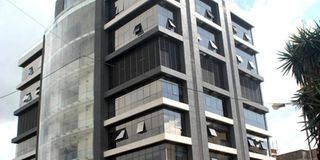Demand for office space hits new high

A new, eight-storey commercial building in Westlands, Nairobi. Factors contributing to high up-take include ease of access to the CBD, availability of public transport and access to social amenities. PHOTO | SALATON NJAU |
What you need to know:
- Value of residential buildings declined in equal measure between August and September
- Most of the demand is for commercial buildings outside the Central Business District (CBD) in places like Mombasa Road, Ngong Road, Gigiri, Westlands, Upper Hill, Lavington, Thika Road, Parklands, Ridgeways and Runda.
High demand for commercial buildings and offices has seen investors in Nairobi rush to cash in on the trend, triggering a surge in the value of construction plan approvals to a 23-month high.
This comes is at the expense of residential buildings whose value has declined in equal measure between August and September last year, data from the Kenya National Bureau of Statistics (KNBS) shows.
Between August and September 2014, the value of building plans ratified by the City County of Nairobi (CCN) rose by 58.2 per cent, valued at Sh12.3 billion from Sh7.8 billion.
Officials at the CCN told Sunday Nation investors were keen to cash in on the rising demand for commercial buildings in Nairobi, both from local and foreign investors. The approvals are for commercial buildings comprising office buildings and warehouses for light industries.
Most of the demand is for commercial buildings outside the Central Business District (CBD) in places like Mombasa Road, Ngong Road, Gigiri, Westlands, Upper Hill, Lavington, Thika Road, Parklands, Ridgeways and Runda.
While decongesting the CBD is a good idea, it presents a planning challenge to the county government on provision of requisite facilities in tandem with the requirements of commercial buildings emerging in areas that were hitherto residential.
“There are new demands in areas like Runda, Ridgeways and Gigiri,” an official at the council said.
On the flipside, the value of plans for residential buildings approved slumped by 25 per cent to a six-month low of Sh9.7 billion in September, from Sh12.8 billion in August.
In the third quarter of last year, rental prices for residentials declined “sharply” after registering strong rises in every quarter consistently for the past three years, according to HassConsult, a property firm.
Investors have now shifted their focus to high-yielding commercial buildings.
OVERSUPPLY OF OFFICES
A recent report by Mentor Management Ltd — Nairobi Office Market Update: On the Brink of Oversupply — indicated that Nairobi will experience an oversupply of offices next year.
The report says that while new office development over the past five years has largely been in line with demand, significant oversupply is expected in the next three years as developers rush to deliver space into an increasingly saturated market.
“We predict that by the end of 2016, there will be over 2.8 million square feet of offices (19 per cent of the total stock of new buildings delivered since 2009) lying vacant,” the report says. Last year was a largely successful one for office developers in Nairobi as Westlands, Kilimani, Ngong Road and Gigiri enjoyed significant up-take levels.
Kilimani recorded the highest up-take for new office space at 84 per cent, followed by Westlands at 71 per cent. Sustained office development outside the CBD has been observed in Gigiri, Thika Road and Karen, accounting for over 25 per cent of total office space delivered in 2014.
The major factors contributing to high take-up in Kilimani and Westlands are ease of access to the CBD, availability of public transport and access to social amenities.
Discovery of minerals like oil, gas and coal, and exploration of titanium is expected to attract more investors. This is coupled with a fast growing professional services sector, banking and insurance and entry of international firms which use Nairobi as a regional hub.





